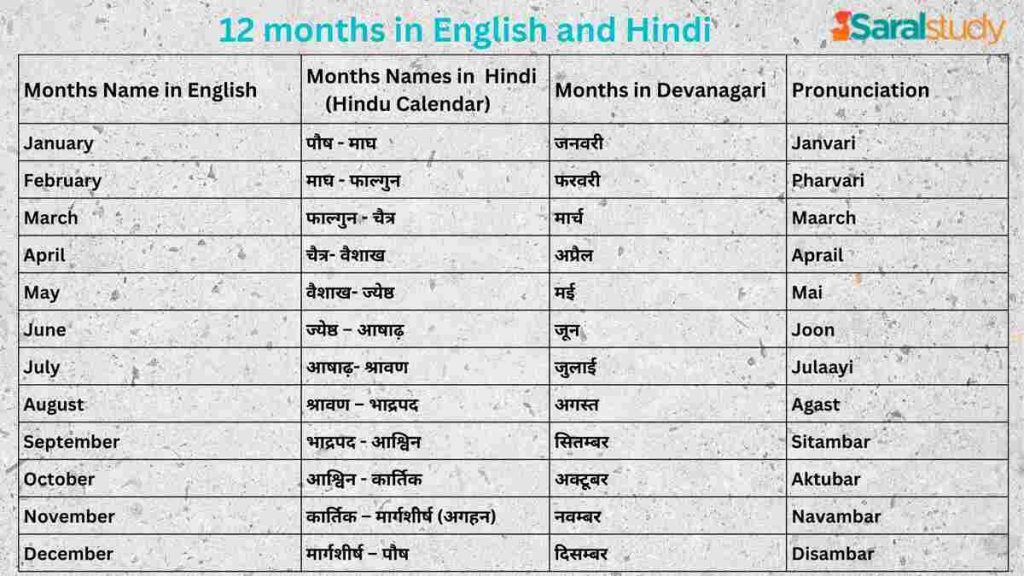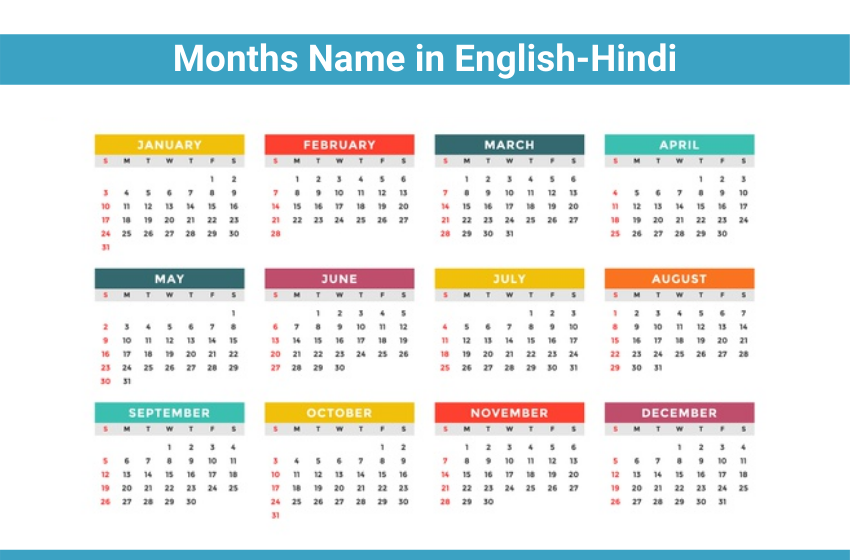All of us know the months of the year in English because they are taught to us in school and also, in our homes, we use the English calendar. But do you know the month’s name in Hindi? It doesn’t matter whether or not you’re a teacher, a student, or a standard person, no matter you’re, however, you use the month, year, week, etc. as a time unit. but the unhappy factor is that several people don’t know the Hindi months’ name. Here, in this article, we will learn about the names of months in Hindi.
12 Months Of The Year – Months Name in Hindi & English
Here you will learn about English months name in Hindi or in a layman language we can say learn about January February in hindi.
[lasso rel=”amazon” id=”5490″]
Name of the 12 months in Hindi and English (12 महीनों के नाम हिंदी और अंग्रेजी में)
Here is the months of the year in Hindi and English with their pronunciation. The most popular calendar is Gregorian calendar (English Calendar), hence the English months name are most known months name too. This calendar consist of 12 months and months name can be learned as:
“January, February, March, April, May, June, July, August, September, October, November, December”.
Each month are further divided in weeks and each month has approximately 4 weeks. Each week consist of 7 days, which can be learned as:
“Monday, Tuesday, Wednesday, Thursday, Friday, Saturday, Sunday”.
| Months Of Year in English | Months Names in Hindi
(Hindu Calendar) |
Months in Devanagari | Pronunciation |
| January | पौष – माघ | जनवरी | Janvari |
| February | माघ – फाल्गुन | फरवरी | Pharvari |
| March | फाल्गुन – चैत्र | मार्च | Maarch |
| April | चैत्र- वैशाख | अप्रैल | Aprail |
| May | वैशाख- ज्येष्ठ | मई | Mai |
| June | ज्येष्ठ – आषाढ़ | जून | Joon |
| July | आषाढ़- श्रावण | जुलाई | Julaayi |
| August | श्रावण – भाद्रपद | अगस्त | Agast |
| September | भाद्रपद – आश्विन | सितम्बर | Sitambar |
| October | आश्विन (क्वार) – कार्तिक | अक्टूबर | Aktubar |
| November | कार्तिक – मार्गशीर्ष (अगहन) | नवम्बर | Navambar |
| December | मार्गशीर्ष – पौष | दिसम्बर | Disambar |
Hindi (Hindu) Calendar
A calendar is generally used to organize days, this is done by giving the name to the period like days, 52 weeks, months, and years. There are so many different types of calendars used around the globe in different communities and one of them is our Hindi Calendar which we also call it Hindu Calendar or Panchang or Panjika. This Panchang is a set of various lunisolar calendars which is used traditionally in Indian sub-continents and Southeast Asia. There is a major difference between the English calendar (the Gregorian calendar) and the Hindi calendar.
Features of the Hindu Calendar
The main features of the Hindu calendar are:
- This is a multi-dimensional calendar which means it offers a multi-dimensional way of structuring time, combining information about lunar days, solar days, lunar months, and solar months as well as the movement of the Sun and the Moon in relation to the settler constellation.
- It consists of 12 lunar months as well as 12 solar months.
Desi Month Name (चैत्र, वैशाख महीनों के नाम in english)
| Lunar Months Of The Year | Solar (civil) Months |
| Chaitra (चैत्र) | Mīna |
| Vaisakha (वैशाख) | Meṣa |
| Jyeshtha (ज्येष्ठ) | Vṛṣabha |
| Ashadha (आषाढ़) | Mithuna |
| Shraavana (Sawan) (श्रावण) | Karkaṭa |
| Bhadrapad (Bhado) (भाद्रपद) | Siṃha |
| Ashvin (आश्विन) | Kanyā |
| Kartik (कार्तिक) | Tulā |
| Agahana (Margashirsha) (मार्गशीर्ष, अगहन) | Vṛścika |
| Pausha (पौष) | Dhanu |
| Magha (माघ) | Makara |
| Phalguna (फाल्गुन) | Kumbha |
- Seasons within the Hindu (Hindi) calendar year start with a New Moon before the Sun enters the Zodiac sign of Aries (Meṣa).
- The Hindu calendar also tracks some more astronomical time spans like Nakshatra, Yoga, and Karana.
- The dates of many Hindu holidays are determined according to the lunisolar calendar which means that the festivals coincide with the Full Moon or a New Moon.
Months name as per Gregorian calendar and Hindu calendar
| Seasons(Ritu) | Months as per the Hindu Calendar | Months (Gregorian calendar/English) |
| Vasanta (Spring) | Chaitra – Vaisakha ((चैत्र- वैशाख) | March-April |
| Grishma (Summer) | Jyeshtha – Ashadha (ज्येष्ठ – आषाढ़) | May – June |
| Varsha (Monsoon/Rainy) | Shravana – Bhadra (श्रावण – भाद्रपद) | July – August |
| Sharada (Late Monsoon/Autumn) | Ashvin – Kartik (आश्विन – कार्तिक) | September – October |
| Hemanta (Early Winter) | Margashirsha (Agrahayana or Agahan) – Pausha (मार्गशीर्ष – पौष) | November – December |
| Shishira (Winter) | Magha – Phalguna (माघ – फाल्गुन) | January – February |
Cultural and Religious Significance of Each Months Of The Year
Each month in the Hindu calendar has specific festivals, rituals, and cultural practices associated with it:
Hindu Calendar Months Of The Year
- Chaitra (March-April): Marks the beginning of the Hindu New Year. Celebrated with festivals like Gudi Padwa and Ugadi.
- Vaishakha (April-May): Known for Buddha Purnima, celebrating the birth of Lord Buddha.
- Jyaistha (May-June): Includes Vat Savitri Vrat and Ganga Dussehra.
- Asadha (June-July): Known for Rath Yatra and Guru Purnima.
- Shravana (July-August): Features Shravan Maas, significant for Lord Shiva devotees.
- Bhadrapada or Bhado (August-September): Celebrates Ganesh Chaturthi and Krishna Janmashtami.
- Ashvina (September-October): Includes Navaratri and Dussehra.
- Kartika (October-November): Known for Diwali, Chhath Puja and Kartik Purnima.
- Margashirsha or Agahan(November-December): Associated with Gita Jayanti and Vivah Panchami.
- Pausha (December-January): Marks Makar Sankranti.
- Magha (January-February): Known for Vasant Panchami and Maha Shivaratri.
- Phalguna (February-March): Features Holi and Maha Shivaratri.
[lasso rel=”amazon-4″ id=”5519″]
Historical Evolution of Months Of The Year Names
The names of the months in the Hindu calendar have evolved over centuries. They are derived from ancient Sanskrit and have been influenced by various dynasties and cultural shifts. Understanding these names offers insights into India’s historical and linguistic development.
January to December in Hindi and English

[lasso rel=”amazon-2″ id=”5494″]
Astrological Insights for Each Months Of The Year
Each month has astrological significance, often aligned with specific zodiac signs:
- Chaitra: Linked with Aries.
- Vaishakha: Taurus.
- Jyaistha: Gemini.
- Asadha: Cancer.
- Shravana (Sawan): Leo.
- Bhadrapada (Bhado): Virgo.
- Ashvina: Libra.
- Kartika: Scorpio.
- Margashirsha (Agahan): Sagittarius.
- Pausha: Capricorn.
- Magha: Aquarius.
- Phalguna: Pisces.
These alignments influence various cultural practices and beliefs in Hindu tradition.
Practical Uses of the Hindu Calendar
The Hindu calendar is integral to daily life, particularly in rural India. It helps in planning agricultural activities, weddings, and other significant events. Farmers rely on the calendar to determine planting and harvesting times, while families use it to choose auspicious dates for weddings and religious ceremonies.
Common Terms and Phrases Related to the Months
- Panchang: The Hindu calendar.
- Amavasya: New moon day.
- Purnima: Full moon day.
- Sankranti: Transition of the sun from one zodiac sign to another.
- Ekadashi: The eleventh day of the lunar fortnight, observed as a day of fasting.
Differences between Hindu and English Calendar
Below are the main differences between the Hindu and English calendars:
| English Calendar | Hindu Calendar |
| The Gregorian calendar (English Calendar) is based on the earth’s revolution around the sun. | The Hindu calendar is based on the Moon’s revolution around the earth. |
| In this calendar, each month out of 12 months has 30 or 31 days except the month of February. February has 28 days normally. Every leap year Feb has 29 days. | Whereas here there are only 30 days in every month. They add an extra full month after every 32-33 months by complex rules to cover the gap of previous days which is known as “Adhik Maas” or “Purushottam Maas” |
| According to this calendar, the year starts on 1 January | The Hindu calendar begins in Chaitra (March-April). |
| The name of the months according to this calendar are January, February, March, April, May, June, July, August, September, October, November, and December. | Here the names are Chaitra, Vaisakha, Jyaistha, Asadha, Shravana, Bhadra, Ashwin, Kartika, Mārgasirsa (Agrahayana), Pausha, Magha, and Phalguna. |
| As per this calendar, there are four seasons; summer, spring, winter, and autumn. | Whereas here there are six seasons; Vasant Ritu (spring), Greeshma (summer), Varsha (monsoon), Sharad (autumn or late monsoon), Hemant (early winter), and Shishira (winter season) |
| In this Calendar, the whole day is divided into 24 hours with 60 minutes in each hour. | Whereas according to this calendar, the day is divided into 15 muhurtas, each of which has 48 minutes and the night is similarly divided. |
| In the Gregorian calendar, the days of the week are named after Roman gods, as well as the sun and moon. | In the Hindu calendar, each week has seven days and those are named for Hindu deities. Each day also corresponds with a separate planet. |
Understanding the months in Hindi and English, along with their cultural, religious, and astrological significance, enriches our appreciation of the Hindu calendar. This knowledge highlights the calendar’s integral role in Indian tradition, guiding daily life and cultural practices.
Frequently Asked Questions
Q1. From which month does the Hindi Calendar start?
Ans. Hindi Calendar starts from Chaitra month (March-April).
Q2. What do we call Ashwin month in English?
Ans. Ashvin (आश्विन or क्वार) or Ashwin month called September in English. Usually, Ashwvin month of Hindi stays between September to October.
Q3. What do we call Baisakh month in English?
Ans. Vaisakha (वैशाख) or Baishakh month of the Hindi calendar called April in English. Usually, the Baishakh month in Hindi falls between April and May.
Q4. What do we call Paush month in English?
Ans. Pausha (पौष) or Paush month of the Hindi calendar called December in English. Usually, the Paush month in Hindi falls between December and January.
Q4. What do we call Kartik month in English?
Ans. Kartik month (कार्तिक) of the Hindi calendar is called October in English. Usually, the Kartik mhina (month) in Hindi falls between October and November.
Read Also: National Calendar of India & History and Uses
Related Articles


भाई बहुत अच्छी जानकारी दिऐ है आप इस पोस्ट से हमको बहुत कुछ सीखने को मिला धन्यवाद
This article is extremely easy-to-read, useful and effective for the target audience. I loved the way you have chosen the right words at the right place so that there is no unnecessary exaggeration. Not a single word has been used extra to just extend the word limit. Each and every line has its own importance and this is what I loved about this post.
Thanks for the valuable information.